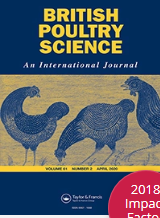Document type: scientific article online pre-publication in British Poultry Science
Authors: I. C. Dennis, S. M. Abeyesinghe, T. G. M. Demmers
Preview: This study showed that it is possible to operate a mobile robot within a batch of broiler chickens between days 3 and 37 of a cycle and that this results in only limited disturbance to the birds' behaviour. Future work will have to repeat this trial on several farms to see whether the use of a mobile robot in the middle of the broiler flocks can be achieved in a commercial setting with limited disturbance of the birds' behaviour.
Modern broiler production in large sheds holding upwards of 50 000 birds uses indoor climate control based on a handful of fixed-location sensors, often well above the bird-occupied zone. Significant deviations from optimal climate conditions for the birds are common, but installing a higher-density grid of fixed sensors is not cost effective. A robotic platform, moving through the flock of birds and collecting detailed spacial information on a wide range of climate parameters at bird level, enables accurate decisions to be made to optimise the climate in large sheds being made in real time.
A preliminary study investigated the feasibility of running a mobile robotic platform among a flock of broiler chickens for an entire 6-week cycle. Bird behaviour in response to the robot was studied.
In total, 1597 Ross 308 broiler chicks were housed in a room that was set up to replicate a commercial environment. The robot was driven along a fixed route three times a day (Monday-Friday) for the whole cycle under manual control. Behaviour was studied using camera footage.
The birds showed very little 'startled' behaviour in response to the robot and were quick to fill the area behind the robot as it moved past. Activity levels increased during robot runs but to a lesser extent than during walk-through by a human stockman. The challenges of operating the robot changed as the birds grew, with many individuals coming into physical contact with the front of the robot later in the cycle. Despite this, very few birds refused to move out of the way completely, and mortality and production parameters remained acceptable throughout.




